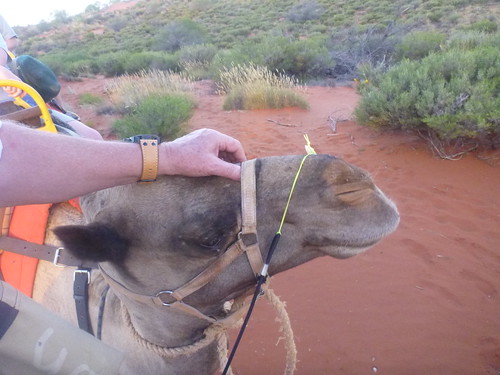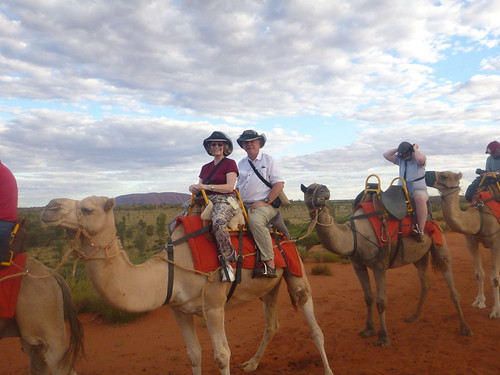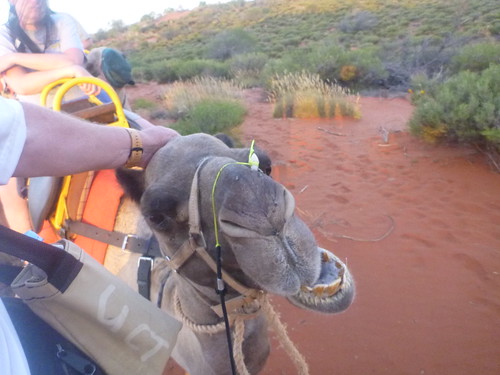When one thinks of the great deserts in this world a camel comes to mind. Not native to Australia, the one humped camels, the dromedary kind, were imported during the Australia's formative years. Yes, Australia has a huge camel population, living wild in the Outback. As a beast of burden, much more able to handle the desert conditions of the Outback than any other animal, it was introduced most likely from Afghan-Indian stock. Camels, like dogs, are separated into different breeds. The breed used in Australia was bred to be strong and can carry enormous weights for days on end without ill effects. Trained cameleers, people that know and could handle camels, flocked into Australia about the same time from the Middle and Far East. Most of the railroad installations, the supplies and wooden railroad ties, the food for the workers, heck, even the workers themselves, were transported by camels into the huge desert of Central Australia, the region we today call the Outback. Whole towns and their supplies, before the invention of the automobile, were constantly supplied by camel caravans.
The strength of those camels is amazing. Camels can comfortably carry half their body weight for 6-8 hours a day. Every day for months on end. A bull camel weighing in between 700kg (1540 lbs. ) to 900kg (1980lbs) can therefor carry 350kg (770 lbs.) to 450kg (890 lbs.) all day long, In temperatures that are on average plus 30 Celsius (92 F) in full blasting sun with no shade available. Temperatures can reach 45C and up in the Outback in summer. A camel's water consumption, or the lack thereof is legendary. A camel needs little water if their diet contains good, moisture-rich pasture. On average they consume 20 - 30 liters of water per day (5-8 gallons) if water is available. If they have gone without water for a long period, they can gorge themselves with water if they need to rehydrate. A camel can and will drink 100 liters (27 gallons) within 10 minutes without any ill effects. A camel can go without water for about a week. Amazing animals and much better adopted for Australia's center desert than a horse. The only drawback, is their walking pace - it is an 'amble speed' of 5 km/h or a little more than 3 miles an hour. They don't like to be rushed. Well, hey, in heat like that, who wants to run? In short spurts, though, they can gallop at approx. 60 km/ h (about 38 MPH). What really made Australia a heaven for camels is that they can eat 82% of all the vegetation varieties native here, so food for them is plentiful. One misconception some people have is that they store water in their hump. Wrong! The hump is pure fat, they use it like a storage container. For lean times they draw on these fat reserves in order to survive.
Carol and I visited one of the camel ranches established near Uluru. Some people had the good idea to tame some of those wild roaming camels and use them as a tourist attraction. Tied in line like a train , those beasts now carry fat American (and Canadian - not so fat) tourists, two up if it's a couple, as burdens. In exchange for plenty of food and water and good treatment, they now carry a slight total weight of 180kg for just an hour, up to four times a day. A good deal for the camel. All seemed happy, the tourist gets a guided, elevated tour through the desert (a fully grown camel stands 1.85m/6 feet at the shoulder and 2.15m/ 7 feet at the hump) for a better view of the surroundings and no sand walking, the camel gets needed exercise with a small load and the cameleer makes a living milking the tourists. Everybody wins!
The slow gait of the camel makes this excursion a pleasant experience. The animals seemed eager and content and from the sounds of the camera clicking tourists, so did they. It did not take very long, though, before the tourists found out that taking pictures from a constantly swaying platform is not easy. The gait of the camel, a camel moves both feet on one side of its body, then both feet on he other side, is a constant rolling, side-to-side motion. Plop, a camera falls into the sand and must be retrieved by the walking cameleer. The lead camel takes it in his head to graze and it needs some coaching by the cameleer rider to make it obey. Ornery is a good word for a camel. Not vicious, but they do not like to be told too much, they do like to do their own thing. Are they kind of like some people you know?











